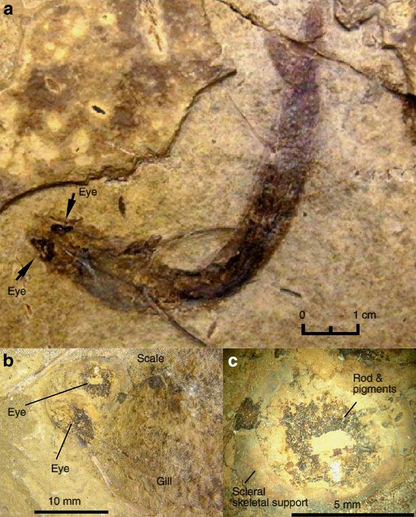Scientists have discovered a well-preserved 300 million-year-old fish with a well-preserved eyeball containing rods and cones that can be seen under a microscope, suggesting that the ancient fish had color vision.
The newly discovered fossil is of an extinct fish species named Acanthodes bridgei. It is about 4 inches long.
It was found in the Hamilton quarry in Kansas, an area that was once a shallow lagoon.
Fossils excavated in this particular area are typically very well preserved because they buried very quickly in the sediments of the lagoon, yielding “exceptionally well-preserved animal fossils in an estuarine depositional setting.”
The discovery provides clues that ancient fish likely had color vision. It is the first time that rods and cones (photoreceptor cells) have been identified in a fossil vertebrate eye.
“Rods and cones are not usually preserved, because these soft tissues are more fragile,” said lead author of the study, Gengo Tanaka of Kumamoto University in Japan.
Rods are cones are found in the retina of human eyes. Rods are more sensitive than cones – but not to color. While cones do provide color sensitivity.

(a) Complete dorsoventrally compressed specimen (NSM PV22244); the head, including a pair of black/dark brown eyes, is lower left. (b,c) Details of the head region and the right eye.
The scientists said:
“This is the first discovery of fossil rods and cones in general and… also the first record of receptors, in a fossil vertebrate eye. These findings indicate that such receptors have been conserved in vertebrate eyes for at least 300 million years,”
It’s well known that the biological vision system has existed for over 520 million years. However, it was unknown when the optical system developed the ability to see in color.
According to the scientists, this discovery of the well-preserved photoreceptors indicate that fish could have had color vision at least 300 million years ago.
Scientists had believed that modern eyes developed millions of years ago and this finding finally provides concrete proof of that.
Tanaka believes the findings will help scientists improve our understanding of the evolution of many vertebrates.
Reference:
- “Mineralized rods and cones suggest colour vision in a 300 Myr-old fossil fish”
Gengo Tanaka, Andrew R. Parker, Yoshikazu Hasegawa, David J. Siveter, Ryoichi Yamamoto, Kiyoshi Miyashita, Yuichi Takahashi, Shosuke Ito, Kazumasa Wakamatsu, Takao Mukuda, Marie Matsuura, Ko Tomikawa, Masumi Furutani, Kayo Suzuki & Haruyoshi Maeda
Nature Communications 5, Article number: 5920 doi:10.1038/ncomms6920
